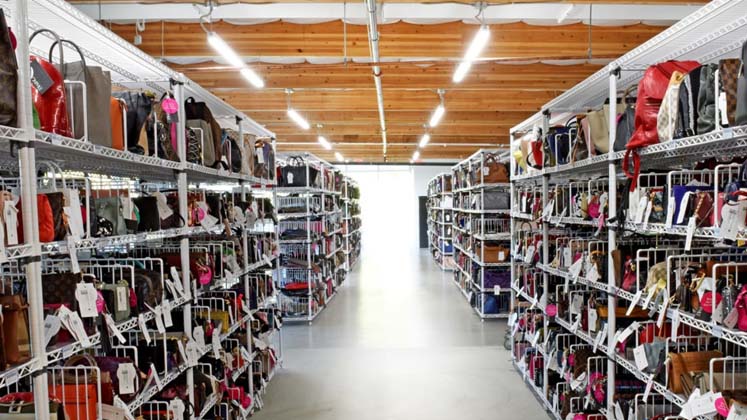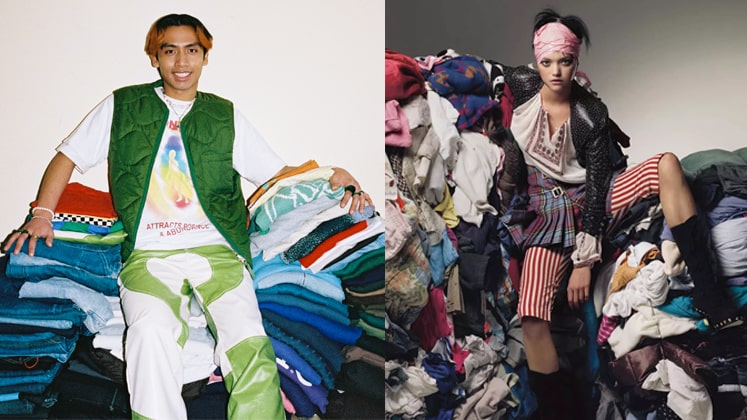Our planet is operating on borrowed time and if humankind does not stop and alter its wasteful ways of living, we will be nearing the end sooner than we can imagine. Thankfully, an increasing number of industries – including the fashion, apparel and textile industry which are classified as the second-most polluting industries in the world – have started to notice and make amends.
As growing concerns surrounding the damaging environmental effects of fast fashion play on consumer mindsets, resale emerges as the latest opportunity in retail for brands and retailers alike.
The undeniable impact of resale
Accelerated by the young adult cohort – especially the Gen Z, resale offers revenue opportunities for brands, while providing a guilt-free and thrifty way to snag a bargain, fill a gap in their wardrobes and get their hands on rare, vintage pieces that are not sold anymore.
After seeing the success enjoyed by third-party apps and retailers such as ThredUp, Vestiaire Collective and The RealReal among many others, brands are launching their own proprietary re-commerce platforms to regain control of the narrative around second-hand items, bringing profits back to brands and opening a second stream of revenue. These platforms also help to make resale more approachable to consumers on a mass scale, with smart new initiatives that bolster brand loyalty, WGSN highlighted in its Owning Resale: Shifts & Strategies 2022 report.
‘With resale bringing an element of fun and authenticity to shopping and proving one of Gen Z’s favourite ways to shop, retailers are adapting to a retail landscape where new doesn’t always equal better. With purpose around sustainability and charity driving many of these purchases, we explore how retailers are slotting re-commerce seamlessly into their existing offerings, while other brands look to collaborate with the buy-to-resell community,’ WGSN cites.
Shifting from online to offline – the next big move for resale
That being said, the current resale market is predominantly saturated online, a trend we will begin to see change in the coming months as brands gear up to harness customer data insights for in-store offerings.
‘The growth of the resale market has been driven by online transactions, with consumers leveraging powerful filtering tools, visual search and automated alerts to find the perfect item. However, resale platforms are branching out to boutique bricks-and-mortar with curated selections, using their online customer data as a guide,’ WGSN states in its report.
Case study: In July 2021, luxury handbag resale platform Fashionphile launched its first sales-focused physical presence at New York based concept store Neighborhood Goods. Having noticed that opening drop-off points in new cities resulted in an uptick of traffic from that geography, Fashionphile reversed the data, using previous online sales from the locality to decide on a curated selection of handbags to offer in-store.
As much as driving in-person sales, a bricks-and-mortar storefront also acts as a discovery channel for new and prospective shoppers who might not yet be aware of a brand, channelling visitors to a greater selection of stock on an e-tail platform. This broadening of utility for physical stores plays into a larger trend for experiential and discovery retail, where value is based on more than cash registered sales.
With competition for customer attention online, many consumers prefer a curated selection of goods and a more limited choice – something that is supported by the one-off nature of resale.
Consumers in the limelight – The Gen Z
Gen Z is changing the name of the game and making brands and retailers alike rethink their existing strategies to cater to changing consumer demands. As a generation keen to create authenticity among copy-and-paste social media looks and meteoric micro trends, Gen Z is looking at resale to stand out from the crowd.
According to ThredUp‘s 2022 resale report, having fun while shopping is among the top motivators for Gen Z to purchase second-hand. They look to thrifting as a gamified retail experience, hunting online as well as offline for the perfect ‘grail’ item.
Unique pieces and rare finds offer authenticity to a hyper-consumer generation, who have grown up with access to any item at their fingertips and are tired of scanning through endless choices presented to them. Pre-loved clothing offers Gen Z, who balance staying relevant on social media with sustainability concerns, bragging rights.
A 2021 report by Depop and Bain & Company revealed that 75 per cent of the woke Gen Z consumers aim to reduce clothing consumption but want to keep an authentic online brand and persona.
Depop has helped make preloved clothing a success with a notoriously variable generation. Over 90 per cent of its customers are aged under 26 and it bridges the gap between storefront and social media channels via public followers and likes on seller profiles.
Gen Z’s embracing of complex, fluid and multifaceted definitions of identity translates into mini personal retail brands within the app, where shoppers can buy into a way of being.
‘Gen Z is redefining resale, highlighting language that shies away from ‘second-hand’ or ‘pre-owned’ by focusing on finding clothes a new ‘forever home’. This emotional language is evident in the 2022 eBay x Love Island tagline, which riffs on the show’s meme’d language: pre-loved has always been our type on paper’ WGSN concludes.
Environmental impact of the digital sector
Nowhere close to the impact that the fashion and textile industry has on the environment, or as visible as e-waste or the pollution caused by tech manufacturing – the digital sector still has a significant environmental impact on the planet that is coming under the radar.
The greenhouse gas emissions of the ICT industry, which represent one per cent of global carbon footprint in 2007, are on course to exceed 14 per cent by 2040.
The University of Cambridge estimates that the amount of electricity consumed by the Bitcoin network in one year could satisfy the electricity needs of its entire university for 1,114 years.
The increase in emissions can be attributed to many factors, including the growth of AI, consumer adoption of the Internet of Things (IoT), data pollution, expanded use of video, advancements in web design and even the increased size of smartphone screens.
Data centres consume around 2 per cent of global electricity, with the potential to consume 8 per cent by 2030. Furthermore, The Shift Project estimates that the energy needed for the production and use of ICT equipment such as servers, networks and terminals is increasing by 9 per cent per year.
Cryptocurrency and blockchain are significant users of energy. The University of Cambridge estimates that the amount of electricity consumed by the Bitcoin network in one year could satisfy the electricity needs of its entire university for 1,114 years.
Despite the current environmental impact, worldwide spending on blockchain solutions is expected to grow from US $ 4.5 billion in 2020 to US $ 19 billion by 2024.
The pandemic also amplified consumer use of digital services, as now nearly 60 per cent of the world’s population is online, up from 8 per cent in 2001.
What does this mean for you?
In its Intelligence: Digital Sustainability report, WGSN highlights that the complexity and far-reaching drivers of this issue will necessitate multi-layered, creative solutions. Understanding where your biggest impacts lie should guide your decision-making.
The rise of blockchain and cryptocurrency

Blockchain technology is alarmingly energy-intensive: one Ethereum transaction is equivalent to 283,714 VISA transactions or 21,335 hours of watching YouTube, while a single Bitcoin transaction is equivalent to 2,620,509 Visa transactions or 197,059 hours of watching YouTube.
Despite the current environmental impact, worldwide spending on blockchain solutions is expected to grow from US $ 4.5 billion in 2020 to US $ 19 billion by 2024, requiring yet more resources.
Intel has estimated that a 1,000-fold increase in computing capability will be necessary to power the metaverse. It will ‘count on algorithms or AI to offer a hundred-fold improvement in computing capacity’. However, a paper from the University of Massachusetts found that training a single AI model can emit more than 626,000 pounds of CO2e – the same as the lifetime use of five cars.
One Ethereum transaction is equivalent to 283,714 VISA transactions or 21,335 hours of watching YouTube, while a single Bitcoin transaction is equivalent to 2,620,509 Visa transactions or 197,059 hours of watching YouTube.
In its report, WGSN highlights that some platforms, including Ethereum, are moving from a proof of work system to proof of stake, estimated to use one of ten thousand of the energy. Other platforms, such as KodaDot, are partnering with offsetting companies to operate as carbon-neutral – although offsetting is often viewed as a short-term fix rather than a systemic solution. Using this system, Polygon plans to become the first carbon-positive blockchain.
How can you action this?
Brands and designers can prioritise low-carbon platforms and mining systems and take inspiration from organisations that are using low-impact blockchain tech as a launchpad for regenerative solutions. WGSN notes that ‘Earth 2070’ is a clean NFT project, controlled by its owners, to fund clean energy such as solar farms, while Celo is facilitating Regenerative Finance (ReFi), by providing a home for the Bank for Other Species, which will fund conservation.
Big data, big footprint

The pandemic’s digital acceleration has resulted in an increased reliance on cloud computing and increasing market growth and demand for data centres, which have the fastest-growing carbon footprint in the ICT sector.
On course to consume 8 per cent of global electricity by 2030, data centres are resource- and energy-intensive. The typical lifespan for servers in a data centre is 3-5 years, but they require a useful life of 11-18 to limit Global Warming Potential (GWP).
Intel has estimated that a 1,000-fold increase in computing capability will be necessary to power the metaverse.
Tech giant Google has pledged to operate on ‘24/7 carbon-free energy’ in all data centres by 2030, while Microsoft has announced plans to use heat from its Helsinki data centre in the district heating network, which could cut 400,000 tonnes of CO2 emissions annually.
WGSN highlights that in this regard, ‘location is key’.
Naver’s planned Cloud Ring data centre in Sejong City, South Korea, will maintain its temperature for 72 per cent of the year by mixing outside air with hot exhaust air from the server room. Cooling can account for 40 per cent of total energy consumption, rising to 80 per cent in warmer climates, therefore companies including Facebook, Google and Amazon all have data centres in Scandinavian countries, WGSN reported.
Microsoft’s Project Natick was conceived to determine the feasibility of subsea data centres. Benefits include lower failure rates and using no water for cooling.
How you can action this?
Take advantage of cool climates and proximity to renewable energy facilities, and track progress in both efficiency and industrial symbiosis for waste. Share your successes: Chinese tech giant Alibaba is participating in the Low Carbon Patent Pledge to share data centre patents and accelerate progress.










